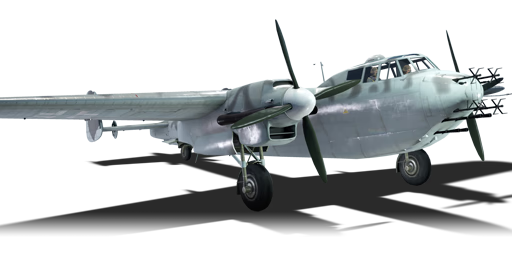



The Do 217 N was one of the many variants built off the Do 217 platform. The Do 217 itself is essentially a bigger, more powerful version of the Do 17. It was a stark contrast to the Do 17 in many ways. While the Do 17 was intended for performance and subsequently had a weak bomb load, the Do 217 had comparable bomb loads to even the He 111. The Do 217 served in many roles, from regular bombing to attacking ships with guided munition such as the Fritz-X radio-controlled bomb. The Do 217 was in service even after World War II with the Swiss Air Force.
The Do 217 N was based off the 217 M, which introduced the Daimler-Benz "DB 603" engine. It provided a substantial increase in power and led to a significant number of subvariants. This also led to the Do 217 N, which was intended for nighttime duties against Allied bomber formations. The 217 N had substantially more armament including the addition of four upward-facing MG 151 cannons mounted aft of the pilot. In theory, pilots would fly below a bomber and then use the upward-facing cannons to attack. An IR spanner and headlight would be used to accurately guide shots on target. The N-2 was a minor development from the N-1 and weighed less due to the removal of the bomb bay equipment.
Introduced in Update 1.39, the Dornier Do 217 N-2 is a very unique aircraft. It is one of the few aircraft in-game that features fixed, upward-facing cannons. The 217 N-2 also comes equipped with the FuG-220 search radar, which can detect targets up to 8 km (4.97 mi) away. In addition to the Schräge Musik cannons, the 217 N-2 also comes armed with four forward-facing MG 151 cannons supplemented by another four 7.92 mm machine guns. With good aim, players can easily destroy fighters and bombers. However, the Do 217 is still a bomber airframe, so it cannot effectively dogfight enemy aircraft. It is highly advised to stick to teammates or pair up with a squadmate who is using a fighter.
flaps
flaps
flaps
brake
| Belt | Belt filling | Armor penetration (mm) at a distance: | |||||
|---|---|---|---|---|---|---|---|
| 10 m | 100 m | 500 m | 1000 m | 1500 m | 2000 m | ||
| IT/IT/APHE/HEI | 21 | 19 | 8 | 3 | 1 | 1 | |
| IT/HEI/HEI/AP-I | 27 | 24 | 14 | 7 | 3 | 2 | |
| AP-I/HEI/HEI/HEI/HEI/IT | 27 | 24 | 14 | 7 | 3 | 2 | |
| APHE/APHE/APHE/IT | 21 | 19 | 8 | 3 | 1 | 1 | |
| FI-T/FI-T/FI-T/IT/IT | 21 | 19 | 8 | 3 | 1 | 1 | |
| HEI/HEI/HEI/APHE/AP-I | 27 | 24 | 14 | 7 | 3 | 2 | |
| Belt | Belt filling | Armor penetration (mm) at a distance: | |||||
|---|---|---|---|---|---|---|---|
| 10 m | 100 m | 500 m | 1000 m | 1500 m | 2000 m | ||
| AP-T/AP-I/AI | 9 | 8 | 6 | 3 | 0 | 0 | |
| AP-T/AP/AI/AP-I | 13 | 12 | 7 | 3 | 2 | 0 | |
| AP-T | 9 | 8 | 6 | 3 | 0 | 0 | |
| AI/AP/AP/AP/AI | 13 | 12 | 7 | 3 | 2 | 0 | |
| Belt | Belt filling | Armor penetration (mm) at a distance: | |||||
|---|---|---|---|---|---|---|---|
| 10 m | 100 m | 500 m | 1000 m | 1500 m | 2000 m | ||
| IT/IT/APHE/HEI | 21 | 19 | 8 | 3 | 1 | 1 | |
| IT/HEI/HEI/AP-I | 27 | 24 | 14 | 7 | 3 | 2 | |
| AP-I/HEI/HEI/HEI/HEI/IT | 27 | 24 | 14 | 7 | 3 | 2 | |
| APHE/APHE/APHE/IT | 21 | 19 | 8 | 3 | 1 | 1 | |
| FI-T/FI-T/FI-T/IT/IT | 21 | 19 | 8 | 3 | 1 | 1 | |
| HEI/HEI/HEI/APHE/AP-I | 27 | 24 | 14 | 7 | 3 | 2 | |












Flight performance | |
|---|---|
Survivability |
|---|
Weaponry |
|---|